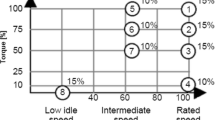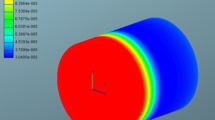Abstract
Nowadays, the selective catalytic reduction (SCR) is a promising solution to fulfill stringent nitrogen oxide (NOX) emission standards enforced by worldwide regulation bodies for lean burning engines. However, in the practical operation, urea deposits occur under unfavorable conditions, which bring about a failure of urea dosing strategy, affect the SCR system de-NOx performance and lowering the fuel economy by increasing the engine back pressure. This paper will present 3D deposit model, which can be used to predict the deposit position. Furthermore, a model-based controls strategy and calibration are designed. The comparison test results of both engine emission tests and vehicle field tests shows there is significant deposits improvement with the embedded model.
Similar content being viewed by others
Abbreviations
- SCR:
-
selected catalyst reduction
- NOx :
-
nitrogen oxide
- Adblue:
-
32.5 % urea solution
- SV:
-
space velocity
- CYA:
-
cyanuric acid
- NSR:
-
NH3/NOX ratio
- DCU:
-
dosing control unit
- ETC:
-
european transient cycle
- F idr :
-
drag force
- F ip :
-
pressure force
- A:
-
frequency factor
- D d :
-
droplet diameter
- E a :
-
activation energy
- R:
-
universal gas constant
- Red :
-
reynolds number
- c HCNO :
-
concentration of HCNO
- Area filmpatch :
-
film patch area
- St :
-
stanton number
- m Deposit :
-
mass of deposits
- m f,lowTemp :
-
mass of wallfilm with low temperature
- w urea :
-
urea mass fraction in the wallfilm
- w miler :
-
limitation of Miller curve.
- m Inj :
-
mass of the injected Adblue
- x stored :
-
percentage of injected Adblue to wallfilm
- m evap :
-
the mass of evaporated water
- m de :
-
urea mass which involved in themolysis reaction
- Pf :
-
wallfilm density
- Vf :
-
the wallfilm volume
- Af :
-
the wallfilm area
- K:
-
heat transfer coefficient.
- c p,f :
-
wallfilm specific heat
References
Bernhard, A. M., Peitz, D., Elsener, M., Wokaun, A. and Kröcher, O. (2012). Hydrolysis and thermolysis of urea and its decomposition byproducts biuret, cyanuric acid and melamine over anatase TiO2. Applied Catalysis B: Environmental, 115-116, 129–137.
Birkhold, F., Meingast, U., Wassermann, P. and Deutschmann, O. (2006). Analysis of the injection of urea-water-solution for automotive SCR DeNOxsystems: Modeling of two-phase flow and spray/wallinteraction. SAE Paper No. 2006-01-0643.
Birkhold, F., Meingast, U., Wassermann, P. and Deutschmann, O. (2007). Modeling and simulation of the injection of urea-water-solution for automotive SCR DeNO x-systems. Applied Catalysis B: Environmental 70, 1–4, 119–127.
Cho, Y. S., Lee, S. W., Choi, W. C. and Yoon, Y. B. (2014). Urea-SCR system optimization with various combinations of mixer types and decomposition pipe lengths. Int. J. Automotive Technology 15, 5, 723–731.
Fang, H. L. and DaCosta, H. F. (2003). Urea thermolysis and NOx reduction with and without SCR catalysts. Applied Catalysis B: Environmental 46, 1, 17–34.
Fischer, S. (2012). Simulation of the Urea-water-solution Preparation and Ammonia-homogenization with a Validated CFD-model for the Optimization of Automotive SCR-systems. Ph. D. Dissertation. Vienna University of Technology. Wien, Austria.
Hauck, P., Jentys, A. and Lercher, J. A. (2007). Surface chemistry and kinetics of the hydrolysis of isocyanic acid on anatase. Applied Catalysis B: Environmental 70, 1–4, 91–99.
Johnson, T. V. (2009). Review of diesel emissions and control. Int. J. Engine Research 10, 5, 275–285.
Kabir, M. N., Alginahi, Y. and Islam, K. (2015). Simulation of oxidation catalyst converter for after-treatment in diesel engines. Int. J. Automotive Technology 16, 2, 193–199.
Kim, J. Y., Ryu, S. H. and Ha, J. S. (2004). Numerical prediction on the characteristics of spray-induced mixing and thermal decomposition of urea solution in SCR system. ASME Internal Combustion Engine Division Fall Technical Conf., 165–170.
Kontin, S., Höfler, A., Koch, R. and Bauer, H. J. (2010). Heat and mass transfer accompanied by crystallisation of single particles containing urea-water-solution. 23rd Annual Conf. Liquid Atomization and Spray Systems, Brno, Czech Republic.
Kuhnke, D. (2004). Spray/Wall Interaction Modelling by Dimensionless Data Analysis. Ph. D. Dissertation. Darmstadt University of Technology. Darmstadt, Germany.
Lü, L. and Wang, L. (2013). Model-based optimization of parameters for a diesel engine SCR system. Int. J. Automotive Technology 14, 1, 13–18.
Schaber, P. M., Colson, J., Higgins, S., Thielen, D., Anspach, B. and Brauer, J. (2004). Thermal decomposition (pyrolysis) of urea in an open reaction vessel. Thermochimica Acta 424, 1–2, 131–142.
Schadel, S. A. and Hanratty, T. J. (1989). Interpretation of atomization rates of the liquid film in gas-liquid annular flow. Int. J. Multiphase Flow 15, 6, 893–900.
Schiller, L. and Naumann, Z. (1935). A drag coefficient correlation. VDI Zeitung 77, 318, 51.
Smith, H., Lauer, T., Mayer, M. and Pierson, S. (2014). Optical and numerical investigations on the mechanisms of deposit formation in SCR systems. SAE Int. J. Fuels and Lubricants 7, 2, 525–542.
Strots, V. O., Santhanam, S., Adelman, B. J., Griffin, G. A. and Derybowski, E. M. (2010). Deposit formation in urea-SCR systems. SAE Int. J. Fuels and Lubricants 2, 2, 283–289.
Tang, T., Zhang, J., Shuai, S. J. and Cao, D. (2014). Urea decomposition at low temperature in SCR systems for diesel engines. SAE Paper No. 2014-01-2808.
Way, P., Viswanathan, K., Preethi, P., Gilb, A., Zambon, N. and Blaisdell, J. (2009). SCR performance optimization through advancements in aftertreatment packaging. SAE Paper No. 2009-01-0633.
Yih, S. M. (1986). Modeling heat and mass transport in falling liquid films. Handbook of Heat and Mass Transfer, 2, 111–210.
Yim, S. D., Kim, S. J., Baik, J. H., Nam, I. S., Mok, Y. S., Lee, J. H. and Oh, S. H. (2004). Decomposition of urea into NH3 for the SCR process. Industrial & Engineering Chemistry Research 43, 16, 4856–4863.
Author information
Authors and Affiliations
Corresponding author
Rights and permissions
About this article
Cite this article
Qian, F., Lü, L., Feng, T. et al. Experimental and 3D, embedded modeling for diesel engine SCR deposit. Int.J Automot. Technol. 18, 219–227 (2017). https://doi.org/10.1007/s12239-017-0021-9
Received:
Revised:
Accepted:
Published:
Issue Date:
DOI: https://doi.org/10.1007/s12239-017-0021-9




